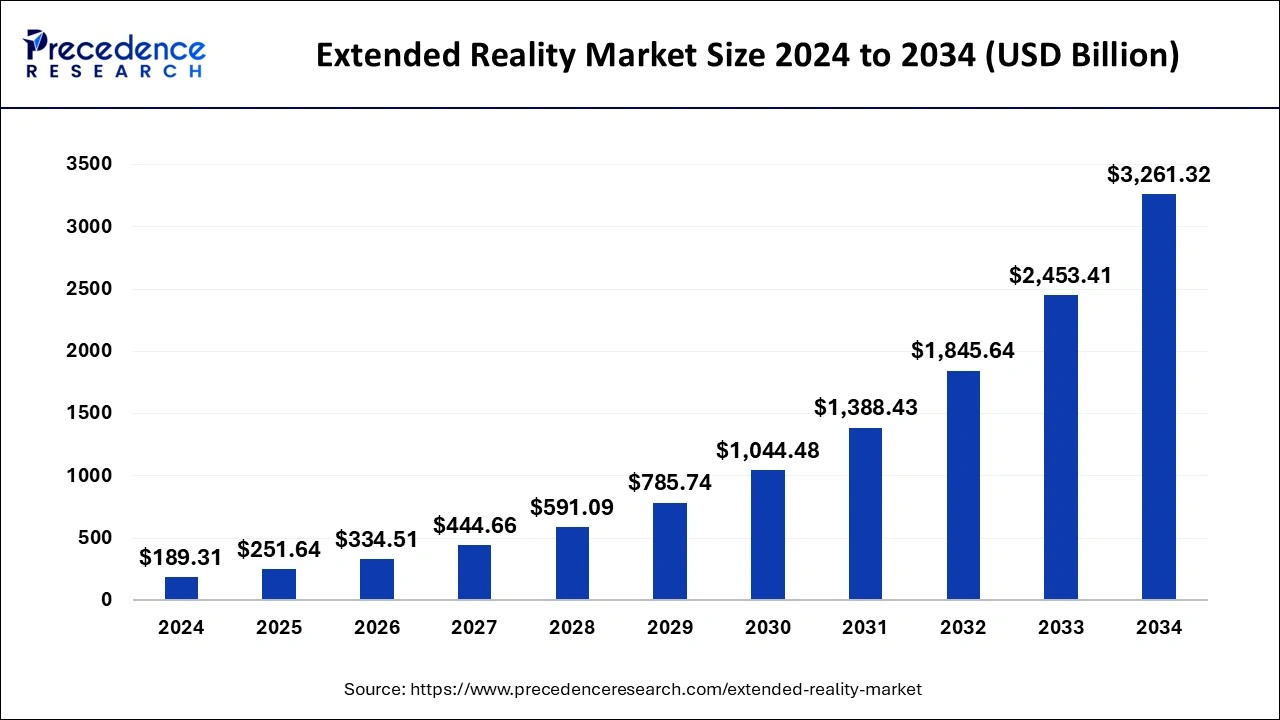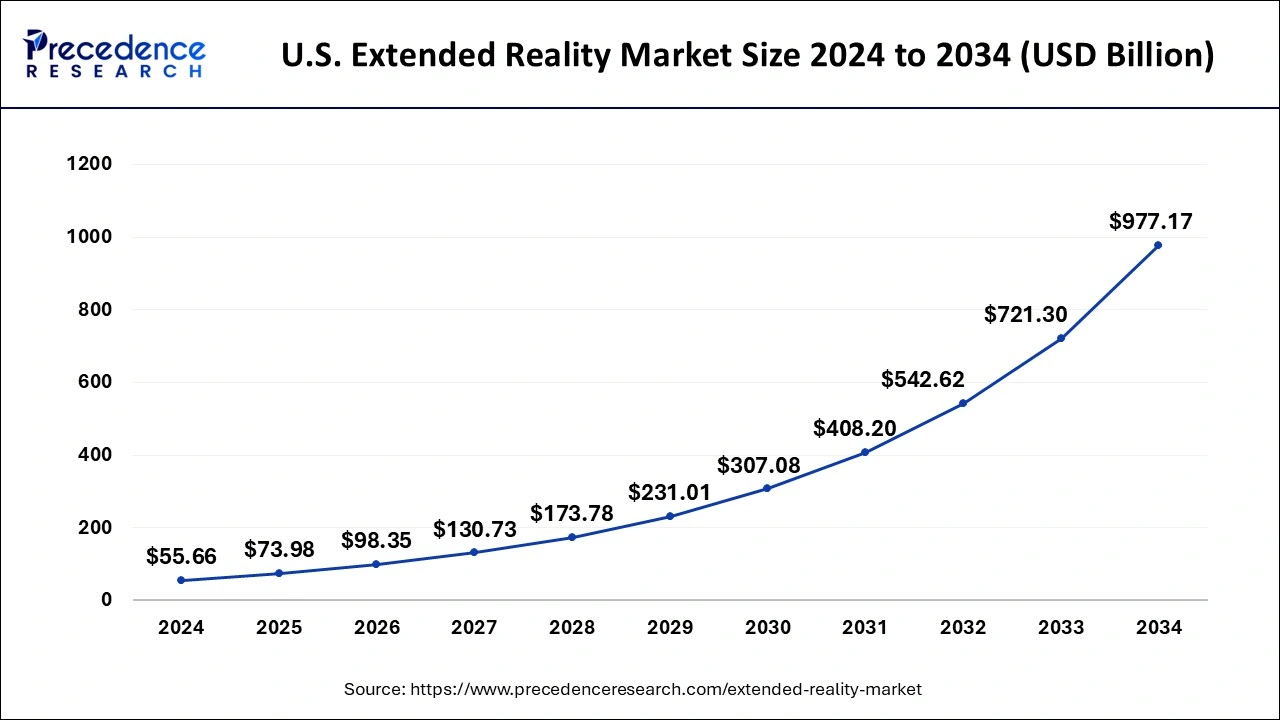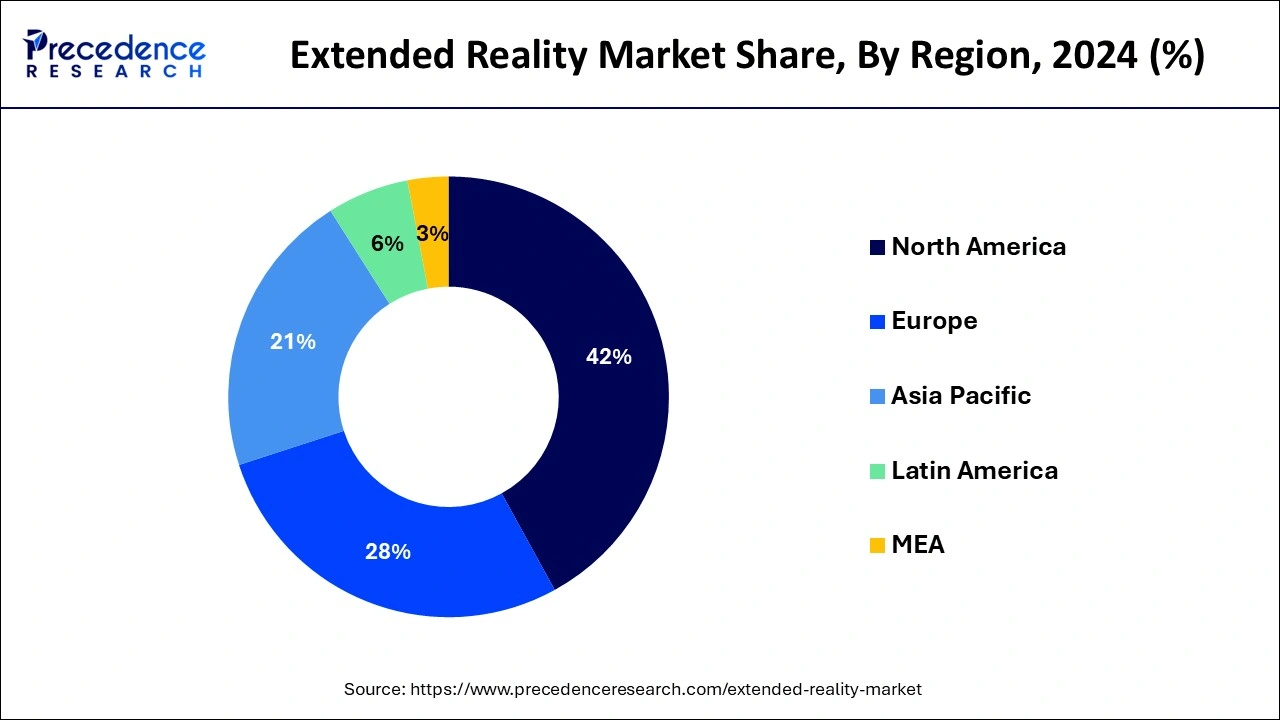January 2025
The global extended reality market size is calculated at USD 251.64 billion in 2025 and is forecasted to reach around USD 3261.32 billion by 2034, accelerating at a CAGR of 32.93% from 2025 to 2034. The North America extended reality market size surpassed USD 79.51 billion in 2024 and is expanding at a CAGR of 33.09% during the forecast period. The market sizing and forecasts are revenue-based (USD Million/Billion), with 2024 as the base year.
The global extended reality market size was accounted for USD 189.31 billion in 2024 and is anticipated to reach around USD 3261.32 billion by 2034, growing at a CAGR of 32.93% from 2025 to 2034.

The U.S. extended reality market size was evaluated at USD 55.66 billion in 2024 and is predicted to be worth around USD 977.17 billion by 2034, rising at a CAGR of 33.18% from 2025 to 2034.

Due to the presence of numerous major companies investing sizable sums in industry advancements, like Microsoft and Qualcomm, North America is anticipated to lead the worldwide market over the projection period. The development of augmented reality (AR), virtual reality (VR), and mixed reality (MR) have been spearheaded by nations like the United States. The majority of the businesses engaged in these technological advancements are based in the US. The high demand in the region is a result of growing technology exposure and the accessibility of smart devices. For instance, customers responded quite favorably to Microsoft's augmented reality device, Hololens, when it was initially made available in North America.

The US Army will get more than 120,000 Microsoft HoloLens augmented reality headsets, according to sources from CNBC. The agreement follows Microsoft's receipt of a contract for the development of Army prototype headsets, which may be valued up to $21.88 billion over ten years. The Pentagon awarded Microsoft a cloud contract with a potential value of $10 billion a year and a half before to this one.
A combination of graphics technologies, including virtual reality, augmented reality, and mixed reality, is known as extended reality. It makes use of software and headgear that provide real sounds and visuals to turn a virtual environment into an interactive one. Currently, it is utilized in a variety of corporate hiring procedures, such as onboarding, and staff training.
Additionally, businesses all around the world not only utilize it to promote their goods and services but also to save money and give customers first-hand experience. Many businesses have transitioned to the remote working environment through the cloud because of COVID-19 and the growing worries about the safety of the workplace. This is the main driving force behind the desire for XR, which enables workers to effectively work from home, attend virtual meetings, and envision an environment for their businesses. In addition, the rise in people choosing gaming as a career due to major advancements in internet speed and the accessibility of cutting-edge gaming equipment is fuelling the market's expansion.
The booming entertainment sector is also boosting the adoption of XR for remote viewing of live concerts and sporting contests on smartphones. Additionally, XR is used in contemporary imaging technologies including computed tomography (CT) scans and magnetic resonance imaging. This is having a beneficial impact on how XR is used in the healthcare sector, along with the increased occurrence of chronic illnesses and the growing need to increase diagnostic effectiveness. Additionally, it is projected that XR's use will increase globally in the defense, transportation, retail, travel, and tourist sectors as people become more aware of its advantages. Although extended reality is becoming more and more popular on a global scale, the high prices of hardware may limit the expansion of the extended reality (XR) industry within the study's allotted time.
Due to growing investments in virtual reality and augmented worlds technologies, as well as to quicken the development of several other technologies and linked devices, the extended reality (XR) industry is expanding rapidly. The popularity of extended reality technology is also anticipated to increase as 5G technology becomes more widely used. Additionally, by enabling a more efficient allocation of processing resources to the network, 5G is anticipated to alleviate some of the main issues with extended reality.
| Report Coverage | Details |
| Market Size in 2025 | USD 251.64 Billion |
| Market Size by 2034 | USD 3261.32 Billion |
| Growth Rate from 2025 to 2034 | CAGR of 32.93% |
| Largest Market | North America |
| Base Year | 2024 |
| Forecast Period | 2025 to 2034 |
| Segments Covered | Type, Components, End-Use |
| Regions Covered | North America, Europe, Asia-Pacific, Latin America, and Middle East & Africa |
The augmented reality (AR) segment contributed the highest market share in 2024. During the projected time, the virtual reality market is expected to expand. The video game industry has embraced virtual reality technologies. A new gaming age that offers gamers an immersive first-person experience has been created through virtual reality (VR). In recent years, virtual reality has improved in both affordability and accessibility. Oculus also announced the Oculus Quest, a stand-alone wireless virtual reality headset.
It is a standalone device that runs an Android-based operating system and can run wireless games and applications. Instead of employing external sensors, it makes use of internal sensors and a multitude of cameras on the front of the headset to enable positional tracking with six degrees of freedom. The "Passthrough" safety function uses the cameras as well, showing a view when a user exits the designated border region.
The hardware, software, and services segments of the global extended reality market are divided based on components. In the near future, it is predicted that the software industry will expand. For instance, AVEVA XR provides a full range of virtual and augmented reality solutions for generating immersive visual surroundings for improved program management and digital training simulations. Industrial Software Products, an AVEVA SELECT Partner, offers augmented maintenance and operation software. It assists in addressing typical workforce difficulties, boosting training efficiency and effectiveness, and mimics equipment settings for complex control and safety scenarios.
The global market for extended reality is divided into many segments based on end applications, including media & entertainment, education, automotive, retail, manufacturing, and aerospace. Due to the extensive use of AR technology by schools and colleges, the education sector is expected to expand significantly in the near future. The COVID-19 outbreak has pushed the usage of augmented reality (AR) advanced technologies in the education industry as instructors look for more inventive methods to teach and provide dynamic information for pupils. Numerous companies in the educational technology sector, such as Neo Bear, Strivr Labs, Corporation, Talespin Reality Labs, Corp, and Health Scholars, are investigating the potential of augmented reality technology for educational applications.
Virtual platforms are gaining ground in the retail and e-commerce sectors to meet the growing client demand for online shopping. In particular, augmented reality (AR) technology may provide customers with a digital "try before you buy" experience and help businesses significantly cut return rates. For instance, Google Arts & Cultures can be used in the classroom. The virus and quarantine have made planning student trips to museums, galleries, theatres, and other locations much more challenging. Without ever leaving the classroom or the house, this Google program enables students to take a virtual 3D tour of some of the most well-known places in the world, experience a day at the ballet, and even go abroad.
By Type
By Components
By End-Use
By Geography
For inquiries regarding discounts, bulk purchases, or customization requests, please contact us at sales@precedenceresearch.com
No cookie-cutter, only authentic analysis – take the 1st step to become a Precedence Research client
January 2025
November 2024
January 2025
July 2024